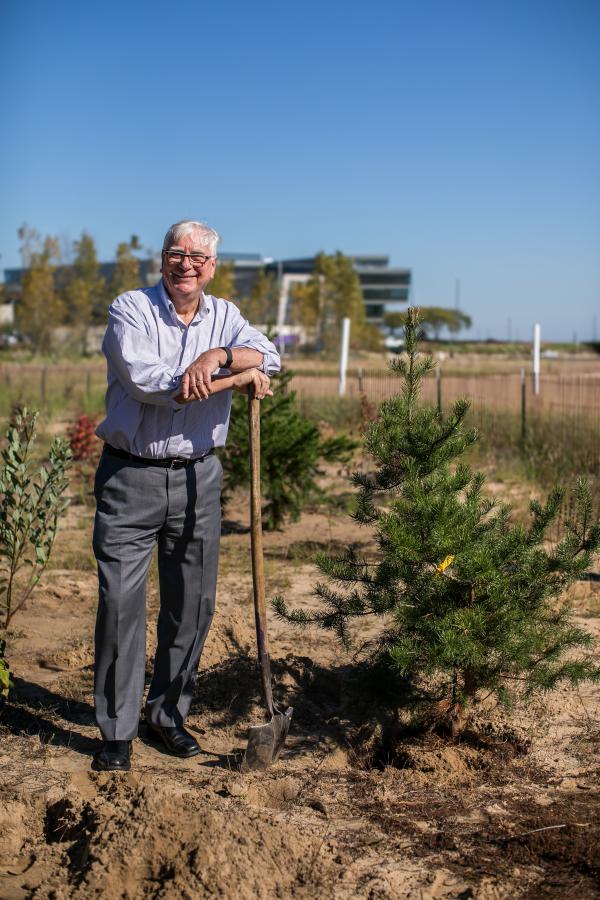RI president says planting trees shows long-term commitment to the community
Ian H.S. Riseley issued a challenge last year. He wanted Rotarians to plant 1.2 million trees – one for every Rotarian in the world – between 1 July 2017, when he took office as president of Rotary International, and Earth Day, 22 April 2018. Clubs around the world have embraced that challenge, and in his travels this year, Riseley himself has often been asked to pick up a shovel.
Q: Why tree-planting?
A: Environmental issues have not featured highly on the radar of Rotary International in a corporate sense since 1990-91, when President Paulo Costa’s Preserve Planet Earth program inspired thousands of clubs to carry out environmental projects. I was keen to give Rotarians an incentive – and the opportunity – to show their concern for the environment. It’s important to me and it’s important to many other people.

As part of 2017-18 RI President Ian Riseley’s tree-planting initiative, members of the Rotary International Staff Society planted eight trees in a bird sanctuary in Evanston, Illinois, USA.
Why trees? Because anyone can do it, just about. If you can’t plant one yourself, you can still support tree-planting somewhere that needs it. From everything I’ve heard, people inside and outside Rotary have embraced this idea.
Q: Why do you think this idea has inspired such enthusiasm?
A: There’s something about planting a tree that speaks to people in a very primal way. It shows a long-term commitment to the community. Rotary does many wonderful community projects: We build playgrounds and clean up rubbish and many other things. But somehow, planting a tree captures the imagination.
I’ve seen many examples of communities getting involved. The government of Romania heard about the initiative and said, ‘We want to plant trees too, but we don’t have the personnel to plant them.’ The government offered to donate trees that Rotarians would plant all over the country. So Rotarians are planting a million trees there.
Q: How do trees fit into Rotary’s areas of focus?
A: In some way, planting trees speaks to all of the areas of focus. Research has shown that trees are good for economic and community development – they increase property values. Planting a tree promotes peace simply by giving people a place to sit in the shade and contemplate the world. Trees are good for disease prevention and treatment, because the world is a healthier place with more trees to produce oxygen and absorb carbon dioxide. You can make a case for trees relating to all our areas of focus.
There are parts of the world where deforestation has caused significant damage. It’s not within the bailiwick of Rotary to redress that; we just don’t have the capacity. But we’d like to demonstrate the importance of having trees in our communities and the difference that they make to us.
Q: The imagery of your presidential tie is the golden wattle, Australia’s national flower. Have you always been interested in plants?
A: I’ve been interested in growing native Australian plants since before I was a teenager. My father was keen on propagating plants. When my wife, Juliet, and I bought our first house, I wanted to create a garden that mirrored what used to occur naturally in the area, with plants that are indigenous to that particular part of Australia. When I was thinking about my presidential tie, it was a no-brainer to incorporate the golden wattle. It’s very colorful. I know some Rotary presidential theme ties have been relatively sedate, and I wanted mine to be slightly out there.
Q: You’ve participated in many tree plantings this year. What have been some more memorable ones?
A: In Iceland, we planted a tree in the Friendship Forest, Vinaskógur, where visiting dignitaries and heads of state have planted trees. Queen Elizabeth II planted a tree there. I’d just note that Rotary’s tree is planted just a little bit higher up the slope than hers.
An organization Rotary works with in South America wanted to plant a tree in Antofagasta, Chile, on the edge of the Atacama desert. I asked if it was practical to plant a tree in the desert. They showed me how they had set up a system to take water from the roof of their building when it rains. The tree can survive and thrive if they do it right.
In Northern California, a massive 100-year-old oak tree had come down, and Rotarians wanted to plant something in its place. The tree we planted is a small thing now, of course, just a meter high. People there were talking about the role that trees will have in the restoration of the area where they had the wildfires last year. A forester I spoke to told me that planting trees helps to stabilize the soil so it doesn’t wash away when it rains. It was a strong reminder of the many benefits of trees – not just converting carbon dioxide to oxygen, but also halting erosion, providing habitat for animals, and so many other things.
I’ve helped plant trees in Sardinia, in Latvia, in Australia. Everywhere I go, I get my hands dirty.
Q: Your tree challenge officially ends on Earth Day, on the 22nd of this month. Do you hope that clubs will keep on planting trees?
A: We want everyone to keep going. And it’s not just planting the tree. It’s nurturing the tree to ensure that it thrives. Planting a tree is a commitment to the future.